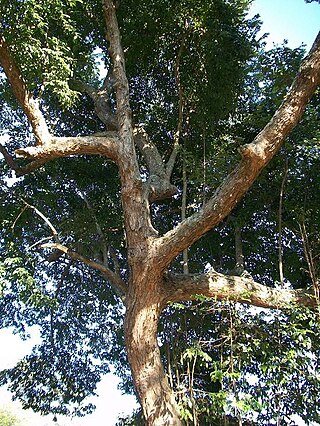
Aleurites is a small genus of arborescent flowering plants in the Euphorbiaceae, first described as a genus in 1776. It is native to China, the Indian Subcontinent, Southeast Asia, Papuasia, and Queensland. It is also reportedly naturalized on various islands as well as scattered locations in Africa, South America, and Florida.

Phyllanthus is the largest genus in the plant family Phyllanthaceae. Estimates of the number of species in this genus vary widely, from 750 to 1200. Phyllanthus has a remarkable diversity of growth forms including annual and perennial herbs, shrubs, climbers, floating aquatics, and pachycaulous succulents. Some have flattened leaflike stems called cladodes. It has a wide variety of floral morphologies and chromosome numbers and has one of the widest range of pollen types of any seed plant genus.

Phyllanthaceae is a family of flowering plants in the eudicot order Malpighiales. It is most closely related to the family Picrodendraceae.
Acidoton is a genus of plant of the family Euphorbiaceae first described as a genus in 1788. It is native to the Greater Antilles, Central America, and tropical South America.

Rauvolfia is a genus of evergreen trees and shrubs, commonly known as devil peppers, in the family Apocynaceae. The genus is named to honor Leonhard Rauwolf. The genus can mainly be found in tropical regions of Africa, Asia, Latin America, and various oceanic islands.

Bridelia is a plant genus of the family Phyllanthaceae first described as a genus in 1806. It is widespread across Africa, Australia, southern Asia, and various islands of the Indian and Pacific Oceans.
Andrachne is a genus of flowering plants in the family Phyllanthaceae described by Linnaeus in 1753. It is one of eight genera in the tribe Poranthereae.

Margaritaria is a plant genus of the family Phyllanthaceae first published as a genus in 1782. It is the smallest pantropical genus of the Phyllanthaceae and, formerly, of the Euphorbiaceae, widely distributed in tropical and subtropical regions of Asia, Africa, Australia, North and South America, and various oceanic islands.

Securinega is a genus of plants in the family Phyllanthaceae, first described as a genus in 1789. As presently conceived, the genus is native to Madagascar and the Mascarene Islands in the Indian Ocean. In the past, it was considered to be much more widespread, thus explaining the long list of species formerly included. It is dioecious, with male and female flowers on separate plants.
- Securinega antsingyensisLeandri - W Madagascar
- Securinega capuroniiLeandri - W Madagascar
- Securinega durissimaJ.F.Gmel. - Madagascar, Mauritius, Réunion, Rodrigues Island
- Securinega perrieriLeandri - W Madagascar
- Securinega seyrigiiLeandri - W Madagascar

Ophiopogon (lilyturf) is a genus of evergreen perennial plants native to warm temperate to tropical East, Southeast, and South Asia. Despite their grasslike appearance, they are not closely related to the true grasses, the Poaceae. The name of the genus is derived from Greek ὄφις ophis, 'snake' and πώγων pogon, 'beard', most probably referring to its leaves and tufted growth. In the APG III classification system, it is placed in the family Asparagaceae, subfamily Nolinoideae. Like many lilioid monocots, it was formerly classified in the Liliaceae.

Hibbertia scandens, sometimes known by the common names snake vine, climbing guinea flower and golden guinea vine, is a species of flowering plant in the family Dilleniaceae and is endemic to eastern Australia. It is climber or scrambler with lance-shaped or egg-shaped leaves with the narrower end towards the base, and yellow flowers with more than thirty stamens arranged around between three and seven glabrous carpels.

Aegopogon is a genus of New World plants in the grass family.
Lachnospermum, common name rooiblombos, is a genus of South African flowering plants in the family Asteraceae.
Poranthereae is a tribe in the plant family Phyllanthaceae. It is one of ten tribes in the family, and one of four tribes in the subfamily Phyllanthoideae. Poranthereae comprises about 111 species, distributed into eight genera. The largest genera and the number of species in each are Actephila (31), Meineckia (30), and Andrachne (22).

Margaritaria discoidea is a tree in the family Phyllanthaceae, commonly known as the pheasant-berry, egossa red pear or bushveld peacock-berry. These trees are native to the warmer, higher rainfall areas of Africa.










